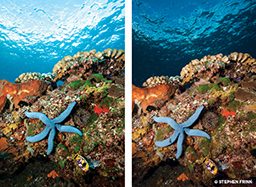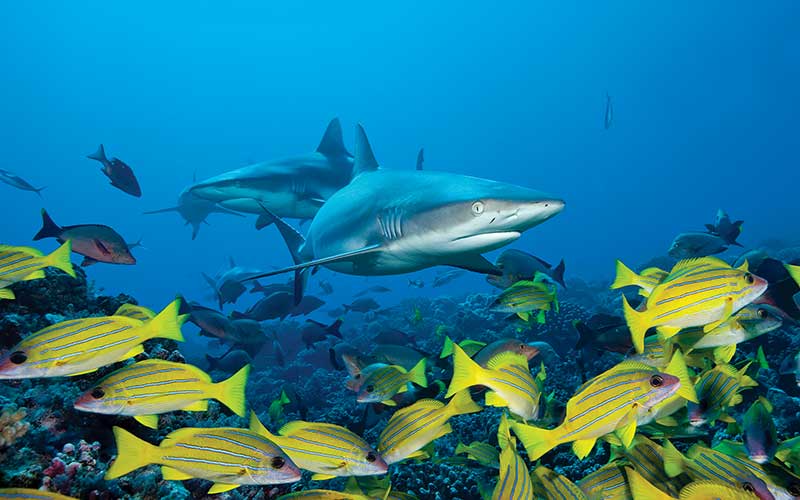Wide-angle underwater photography is the discipline I most enjoy. That’s not to say I don’t like puttering about a subject-rich environment in Indonesia or Papua New Guinea with my 100mm macro lens, capturing pygmy seahorses and nudibranchs. But my career has always been more about telling the editorial story of a destination or providing illustrations for product ads. In the realm of commercial underwater photography, the wide-angle lens is the tool of communication, and using it well is an art.
Why a Wide-Angle Lens?
With water 800 times denser than air, photographic options are more restricted underwater than topside. To capture good color and resolution, working close to the subject is necessary. Close, in this definition, is within 5 feet, preferably within three. So if the subject is big, such as a diver or a reef scenic or large marine life, only a wide-angle lens will do. By wide angle I’m referring to lenses from 24mm, covering 84° on the diagonal, to 180° coverage on the fisheye lens (in 35mm equivalents).
Dome Deductions

Despite the many advances in digital cameras and optics, the optimal use of a wide-angle lens underwater still depends on exact placement of the lens relative to the dome as well as the diameter and curvature of that dome. Gomer McNeil wrote about this in his seminal 1968 text, Optical Fundamentals of Underwater Photography; nothing has changed since then. The principles he describes remain the science that guides housing manufacturers.
Most housing designers are critically aware of which diameter domes go with which lenses, and how a port extension of a specific length may be required to put the nodal point of the lens at precisely the correct orientation relative to the dome. Theoretically, photographers should be able to follow the recommendations of a particular housing maker to get the most out of their wide-angle lens, but the reality is that some lenses just poorly adapt to life behind a dome. Furthermore, some theoretical evaluations of port theory fall short of real in-water experimentation. I recommend popular websites like www.wetpixel.com, www.divephotoguide.com and www.uwphotographyguide.com for extensive threads and tutorials relative to real-life experiments relative to port and port extension combinations to render the best possible performance with a given lens. The search function in their forums can save hours of personal angst and testing when dialing in a new wide-angle lens.
The Quality of Light
To differentiate between the random nature of a snapshot and the calculated discipline of wide-angle art, one has to be able to integrate both horizontal and vertical light, for each plays a critical role in wide-angle image capture.

Vertical light. This is what passes down from the sun, through the water column. It is affected by time of day; in early morning and late afternoon, far more light bounces off the water compared to midday. Surface chop and water clarity likewise determine how much light penetrates, but the largest contributor is depth. In some waters, light is diminished by a full f-stop or more per 10 feet of depth, so there is a massive difference in ambient light falling on a shallow coral garden versus a deep shipwreck. The wide-angle photographer needs to account for that.
Horizontal light. This is the light emitted by the strobe, and it is controlled by variables that include strobe power, strobe-to-subject distance and the reflectivity of the subject. Since the light has to go from the strobe, through the water and then reflect back to the camera sensor, distance is again critical. But while vertical light may be on the order of one f-stop per 10 feet of depth, horizontal light can be as great as one stop per 1 foot of distance. Clearly, a submersible strobe is not as strong as the sun and can’t punch through the water in nearly the same way.
Any photo is affected by a confluence of shutter speed, aperture and the sensor’s sensitivity to light in the form of the ISO. But in practice I find that the horizontal light is most dependent on f-stop, while the vertical light depends most on shutter speed (ISO being a constant). This is obviously an over-generalization, for too slow a shutter speed in shallow water can force overexposure due to vertical light, just as too small an aperture can force underexposure even with a relatively slow shutter speed. But the creative photographer will learn to play with strobe power and aperture to influence the light in the foreground of a wide-angle shot, while they may shift shutter speeds to find just the right shade of background water. The immediacy of review of the digital image makes this kind of experimentation intuitive and rewarding.
Strobe Success
Ideally, the strobes used for wide angle will have a broad beam angle. That’s the most common sense attribute of the strobe and is typically engineered by means of a reflector design, strobe tube and the addition of an external diffuser. The diffuser spreads and softens the light, but at the expense of strobe intensity falling on the subject. A diffuser that is easily added and removed from the strobe head is an asset. Other less obvious attributes include:
Power. I like a wide-angle strobe with ample peak power. Sometimes it has to punch through a lot of water, as in the full-power shot of the humpbacks above, although normally it is at much nearer strobe-to-subject distances, and I’m working at half-power or less. Having the power when needed is handy, but having a strobe strong enough so that quarter-power is sufficient for many shot scenarios plays to the next point:
Speed of recycle. Many of the things we shoot wide angle are behavioral or benefit from a wide range of quick compositional brackets. Sometimes we are in shipwrecks or caves, where we have to work quickly before exhaust bubbles or fin strokes stir sediment into suspension. Or sometimes we’re simply at depth, photographing ships or structures that allow little bottom time. In any case, a strobe that recycles quickly is critically important. Being able to work most often at quarter- or half-power of a powerful strobe is generally more efficient than shooting at full power on a less powerful one. This affects both recycle time and the number of flashes per battery charge.
Color temperature. In digital imaging, we needn’t be as obsessive about capture color as we might be with analog, because in capturing RAW we have the opportunity to tweak white balance easily in almost every processing software. But these are global changes to the image. Strobe color is like painting with light; you’ll need to dab the right hue to your foreground. Typically, a diffuser will slightly warm an image, but there are significant color temperature differences among the various strobes on the market. As this is highly subjective, there will be personal preference involved.

Anyone who has been an underwater photographer for more than two decades will likely recall the fight for global dominance between the Oceanic 2001 and Subsea MK150 as an example of two philosophically differentiated strobes. The Oceanic had a slightly cooler color temperature and was championed by Chris Newbert with his remarkable marine-life photos from the late 1970s. At the same time, Rick Frehsee was the king of wide-angle work with models, and he preferred the warm glass-beaded reflector of the Subsea. Shooting macro with the Subsea created images that were too yellow, and photographing the bikini-clad models Frehsee preferred with the Oceanic created flesh tone biased to blue. While we clearly have more control over color today than Newbert and Frehsee did back in the day, the native color from the strobe head clearly matters.
Hand-Held vs. Fixed-Strobe Placement
It is imperative to place the strobe accurately in a wide-angle shot. Too far forward and it will show up at the periphery of the frame; too far back and it won’t provide the intensity of foreground color necessary to define the primary subject. The key to proper strobe placement is an articulated strobe arm with enough length to place the strobe head at the precise sweet spot, with a ball joint secure enough to hold it in place. Boutique manufacturers like Ultralight Control Systems have made it their life’s work to fine-tune their camera tray and arm sets, studying the smallest issues of balance and ergonomics to provide ever-greater value for their shooters.
Personally, I often shoot my wide angle with a single hand-held strobe. I know that’s counterintuitive since the wide-angle coverage of a superwide may need the combined beam of a pair of diffused strobes. But as I consider the vertical light from the sun an equally important light source, I like quickly and intuitively to be able to move the strobe head around enough to light the foreground creatively. With some subjects, like sharks swimming into the lens, the action happens so quickly it is impossible to bracket apertures. Moving the strobe more to the rear as the shark charges the front maintains the same relative strobe-to-subject distance and, therefore, proper exposure. Another plus: Maneuvering through tight passages in shipwrecks or tunnels with a single strobe is much easier.
© Alert Diver — Q1 Winter 2011